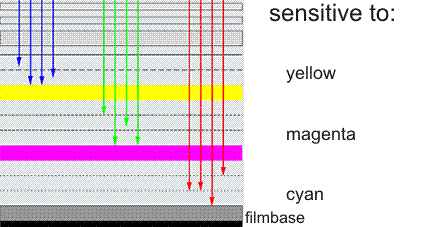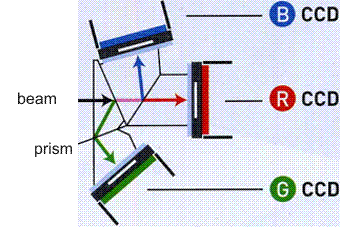|
Here is the new site for products and service: |
||||||||||||||||||||||||
|
movie.project-consultant.net |
||||||||||||||||||||||||
|
|
||||||||||||||||||||||||
|
|
||||||||||||||||||||||||
|
Super8 technology - film.project-consultant.net Mike´s cams |
|||
|
last modification: february 10th, 2012 |
|||
|
Movies with high imagequality - only with film. |
|
Which one is the best: old film - digital video - DV - HDV ? |
|
Comparision of optical capabilities |
|
|
(real HD cameras with 1/2”sensors and 1920 pixels (vertical) must compare with 16mm film which has (calculated) more than 2400 pixels ) But be aware:Video uses lossfull compression and a lot of HD-video cams can only store 1400x1080 pixels - limitation of internal datatransferspeed) |
|
Recommendations for usage of film or video at the end of this page.. |
|
Please let me explain in brief the technical background: |
|
Fim in general (2011): Filmmaterial for photo and cine/movie cameras uses emulsions of chemical materials which are lightsensitive and has to be developed by a chemical process after filming. This emulsion is placed in a sandwich (picture forming layers and filter layers) on the clear acetat or polyester (Kodak and Fuji) filmbase. Light sensitive materials are made from silver particles. Black and white film (2011): The silver particles will be washed out during processing at areas which has got fewer light. Clumbs of this particles are called grain. B/W film can have highest sharpness due to finest grain! Today photographers can buy B/W film with 750 lines/mm and more (1000:1) this can be more than many lenses are made for. Using this for 35mm cinefilm master copies, which uses only 24,9x18,7mm - this is comparable to 34 Megapixels for each colour - for yellow, cyan, margenta more than: 100 Megapixels for each colour frame ! Unbelievable! Do you understand now why Hollywood´s producers and others uses b/w analog film for each colour as a master longterm copy? They want to save and protect their expensive production from dataloss! The rest of the normal cinema world gets their lossfull digital copies Film is for highquality, worthfull productions and archives - 100 up to 500 years are possible if stored well! |
|
|
||||||||||||||||
|
Granularity Actual filmmaterials granularity is nearly the same like humans vision background noise. You can “view” it in darkness or with closed eyes. The reason for this is neural activity and the granularity of optic nerves at the eyes background. The granularity of films is depending of filmspeed, kind of film (colour or b/w) and also processing. The granularity of film is not directly comparable to digital pixels. But for modern 35mm colour films you can assume more than: |
|
35 Megapixels for each frame |
|||
|
Video: |
|||
|
|
|
The objectives for engineering is to develop higher pixel/sensor density. On the other hand there is the huge amount of data to transfer and to store inside the camera. There are technical limitations for datatransferbandwith. Therefore compression is absolutely necessary. But videocompression is allways a loss of informations (dependant of intelligent algorithms) Video technology is made for TV and home use. DV- Video has vertical pixels around 0.7 k (720 pixel for PAL) and HDV with 1440 or 1920 pixels. The sensor has only one sensibility (~filmspeed). The cameras amplifier increases signals from the sensor and the camera can run also in very low light (1 Lux). Unfortunately this increases also free electrons (not light emitted by sensors) which are responsible for visible noise. Also in higher temperatures the sensors and electronics produces visible noise. The real sensor sharpness is lower for video (also HD) than for film. The software of the camcorder tries to eliminate this lack by “sharpening” edges/corners and lines by filling pixels. This gives a “artificial” sharpness feeling to a lot of viewers. Maybe comparable to music from CD which is not true and seems to be “artificial clear”. Movements: normal Video pictures are seperated horizontical into lines. Every 25 Hz (1Hz=25000 part of a second) one half of the picture (a line followed by a gap) is recorded and presented. After this the other half (gap followed by a line) is recorded or shown (50i). Due to inertia for humans visibility it seems to be one picture! Only highend HDTV uses 50p For analogue movie each frame is a complete picture and will be presented in 18 or 24fps. Fast movements results in slightly flickering. Video film seems to be better , more flowing as 24 fps (or 18 fps) Super8 film, .but with less sharpness! (35 mm analogue moviefilm will also run smooth with 48 fps - every picture is twice on the film - actually this is the best technology!) Another important lack is shock sensitivity for this kind of video cameras which are made with smallest parts from plastics and thin plastic-housings! Materials, electronic layout/components for consumerproducts have MTBF (MeanTime Between Failure) which is very low and sufficient only for time of warranty. Nothing for real outdoor or professional usage and long durability.. |
|
Conclusion:
|
|
Recommendation: |
|
for longterm archives, for documentations, for classical and worthfull movies please use analog filmmaterial and store it well Use digital copies for quick usage.... |
|
|
My comment: |
|
Digital technique is allways cutting, seperating. It has no advantages in the analogue world of light or sound. There is allways a gap and a loss between the cuts (eg. pixels). Digital technique can not reach or simulate the reality. It is only possible to get closer, nothing else. This is the reason for synthetic, artificial feeling of people watching video or hearing CD´s. The reason to use digital technique are:
Unfortunately the digital cinema is reality today in hightec countries. Cinema projectors (large beamers) produce only pixel pictures without the reality, colour, sharpness and true movements or panning of fine acetat or polyester film.......You can see the large pixels on the moviescreen now! But the most people do not know: and realize this facts. This technic is only quick and dirty and some steps backwards to quality! If you are lucky to view a 35mm or 70mm master you see at once the difference and absolutely high quality. The fast produced 35mm copies which normally entered a cinema shows not the real possibilities of analogue film. Real analogue cinema and films will be in the future for filmartists, high quality productions or archival. The fast producing moviemakers of the industry in Hollywood, China or other industrial countries tries to force digital technology and will loose quality..........and the consumer uses video as a quick and cheap possibility without knowing the consequences. Only if the BIG TWO (KODAK and FUJI) will change their marketing the analogue film has a good chance to survive as an exclusive product.....its not necessary to compete against digital techniques. It is necessary to push the high quality, the archival properties. Its possible to give film a public image of individuality, worthfull - for people who have time and money to do filming. Its a little bit like vintage or retro cars - today the owner is proud and lucky to drive one - he is a winner
|

